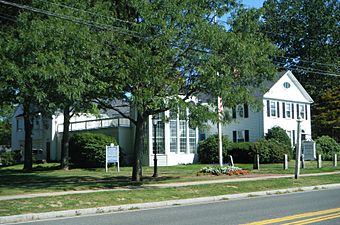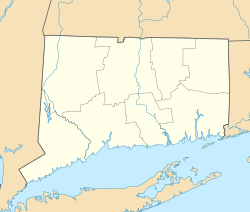Glastonbury Historic District facts for kids
Quick facts for kids |
|
|
Glastonbury Historic District
|
|
 |
|
| Location | Roughly Main St. from Hebron Ave. to Talcott Rd., Glastonbury, Connecticut |
|---|---|
| Area | 128 acres (52 ha) |
| Architectural style | Colonial, Greek Revival, Queen Anne |
| NRHP reference No. | 84001011 |
| Added to NRHP | August 2, 1984 |
The Glastonbury Historic District is a special area in Glastonbury, Connecticut. It's found along Main Street, from Hebron Avenue to Talcott Road. This district is like a time capsule! You can see buildings from the 1600s, 1700s, and 1800s. It shows how the town's architecture changed over many years. This important district was added to the National Register of Historic Places in 1984.
Contents
Exploring Glastonbury's Historic Past
The Main Street in Glastonbury was once a path used by Native Americans. This path ran close to the Connecticut River. In the 1600s, settlers came to this area. The town officially recognized this path as a road later that century.
A Walk Through Time on Main Street
Today, Main Street still follows its original path. It has wide sidewalks and grassy areas. The houses are set back from the road. When the town was first settled, land was given out in long strips. These strips went from the road all the way to the river. You can still see this pattern in some land ownership today.
Near the middle of the district is the town's original center. This area includes a small green space. There's also the old town hall, built in 1840. It is now a museum for the historical society. You can also find an old cemetery there.
Glastonbury did not get railroads or big factories in the 1800s. This meant the area stayed mostly residential. It grew with many different styles of homes. These include Colonial, Greek Revival, and Queen Anne styles. There are 81 buildings in the district that help tell its history.
Homes from Long Ago
The historic district stretches along Main Street. It goes from Hubbard Street in the north to Talcott Street in the south. There are 23 houses in this district built before 1800. This is one of the largest groups of such old homes in Connecticut! Most of these homes are made of wood. The very oldest ones often have special "gambrel" roofs. Later Georgian-style houses have pointed "gable" roofs.
You can also see some brick buildings. Most of these were built in the 1800s. This includes the old town hall and the current town hall.
Famous People from Glastonbury
Some important people lived in this historic district. Several members of the Welles family lived here. Thomas Welles was an early governor of Connecticut. Another famous resident was Gideon Welles. He served as the United States Secretary of the Navy during the American Civil War.



